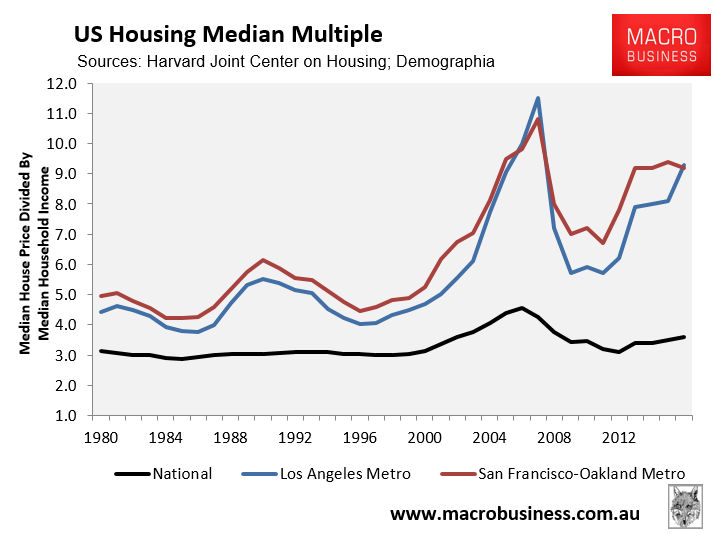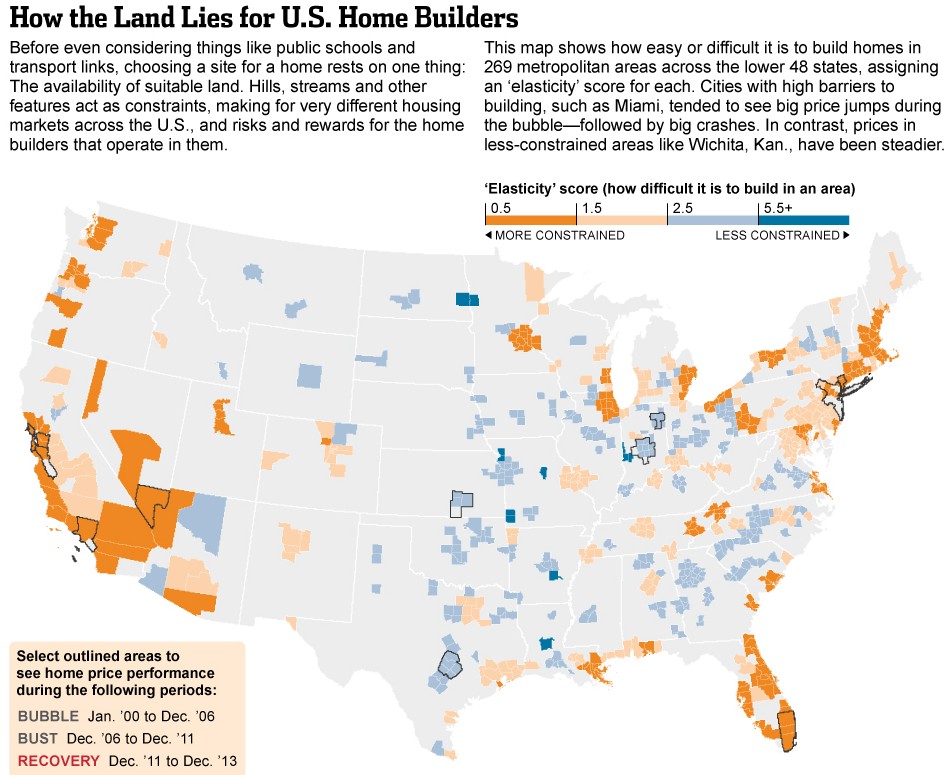For years I have argued that markets where land supply is unresponsive (inelastic) – via planning constraints or geographical barriers – are far more prone to suffer from more expensive housing, higher house price volatility, and bigger boom and bust cycles than markets where land supply is relatively responsive (elastic) to changes in price.
These dynamics were explained in detail in my 2013 presentation to a mortgage risk roundtable in Melbourne (available for download here).
In essence, housing markets where strict regulatory barriers are in place – such as urban growth boundaries, restrictive planning/zoning requirements, minimum lot sizes, and upfront development taxes – are incapable of quickly and efficiently supplying low-cost housing.
These supply constraints thereby ensure that increases (decreases) in housing demand feed primarily into higher (lower) prices instead of changes in affordable new construction.
The perceived land/housing shortages and rising prices during the upswing also encourages speculative demand and ‘panic buying’ from first-time buyers, which assists in driving home prices up even further. However, when the economy and sentiment sour, such as in the wake of the financial crisis in the US, the slump in housing demand can cause prices to collapse.
The Los Angeles and San Francisco Bay Area metropolitan areas are a classic example of how land-use constraints have caused house prices to be both volatile and expensive:

California has operated strict growth management (“smart growth”) policies since the 1970s, whereas Los Angeles and San Francisco are also hemmed in to a degree by the ocean, mountains and in the case of Los Angeles the Mexican border to the south. This has cause housing supply to be unresponsive to changes in demand, with frequent boom and bust cycles and unaffordable housing the result.

Earlier this year, Los Angeles residents sought to ban major developments, in a move that was certain to further stifle supply, increase price volatility, and make housing even less affordable. From the Wall Street Journal:
Voters in the second-largest U.S. city are considering a measure that could effectively halt major real-estate projects…
Many longtime residents have become resentful of new towers that cast shadows over their neighborhoods of single-family homes and push up rents…
Now some activists are pushing back with actions that threaten to grind housing production in some cities to a crawl… The moves threaten to further constrict a tight supply of housing…
In Los Angeles, residents in early March are set to vote on a ballot initiative that, if passed, would suspend for two years any development that requires a modification to the city’s existing planning rules. Currently, such modifications are routine for new developments…
Despite complaints in Los Angeles about a deluge of development, housing construction now is at only a fraction of the rate of the mid-20th century, before strict zoning rules were put in place. From 1950 through 1959, about 250,000 units of new housing were added in the city of Los Angeles, according to an analysis of census data by advocacy group Abundant Housing LA. From 2010 to 2015, the figure was 25,000, though the city issued permits for about 50,000 units in roughly the same period…
Now those locked-out of California’s expensive housing market are fighting back, with the so-called YIMBY movement (“yes in my backyard”) taking hold. From The Guardian:
When a woman stood up and waved a courgette in the air at a City of Berkeley council meeting this summer, complaining that a new housing development would block the sunlight from her zucchini garden, she probably felt confident that the community was on her side. After all, hers was the kind of complaint – small-scale, wholesome, relatable – that has held up housing projects for years in cities around the world.
She didn’t expect the wrath of the yimbys.
“You’re talking about zucchinis? Really? Because I’m struggling to pay rent,” retorted an indignant Victoria Fierce at that 13 June meeting. Fierce went on to argue that it was precisely the failure to build new housing that is causing rents to climb in San Francisco, to the point that she can barely afford to live anywhere in the Bay Area…
The movement is fuelled by the anger of young adults from the millennial generation, many of whom are now in their late 20s and early 30s. Rather than suffer in silence as they struggle to find affordable places to live, they are heading to planning meetings en masse to argue for more housing – preferably the very kind of dense, urban infill projects that have often generated neighbourhood opposition from nimbys (“not in my back yard”).
The birthplace of the yimby movement, the San Francisco Bay Area, has among the highest rents in America. It added 307,000 jobs between 2010 and 2013, but built fewer than 40,000 new housing units, according to state of California estimates.
“It’s clear that this is a housing shortage – and the answer is to build housing,” says Laura Foote Clark, who heads San Francisco-based Yimby Action. “You generate policy by yelling about things.”
Clark and other members of yimby groups consider themselves progressives and environmentalists, but they’re not afraid to throw the occasional firebomb into the usual liberal alliances. They frequently take aim at space-hogging, single-family homeowners and confound anti-capitalist groups by daring to take the side of developers, even luxury condo developers. They have started a “sue the suburbs” campaign that targets cities that don’t approve big housing projects and have even attempted to take over the board of the local Sierra Club…
Yimby groups want to reduce the need for cars by building dense, infill housing close to transportation. They want to do away with suburban sprawl. Most of all, they want somewhere to live…
The net wealth of millennials in the US today is only about half of what of their parents’ generation, the boomers, had when they were the same age in 1989, according to Young Invincibles, a research and advocacy group. The typical millennial has accumulated about $29,000 in assets compared to $61,000 amassed by those in the boomer generation by 1989.
Millennials have been labeled the “avocado generation”. Perhaps baby boomers should be labeled the “zucchini” generation?
But seriously, the interesting thing about this issue is that “over-development” is really a symptom of the pressures from population growth, which itself is driven mostly by immigration. And yet Californian residents overwhelming supported (2-to-1) Hilary Clinton during the US Presidential Election, who was in favour of mass immigration, whereas Donald Trump is opposed.
It seems contradictory for Californians to be supporters of mass immigration while at the same time decrying development, since they go hand-in-hand. It is even the case for the marginalised youth can’t bring themselves to call for managed population growth so that they can have a roof over their heads.

